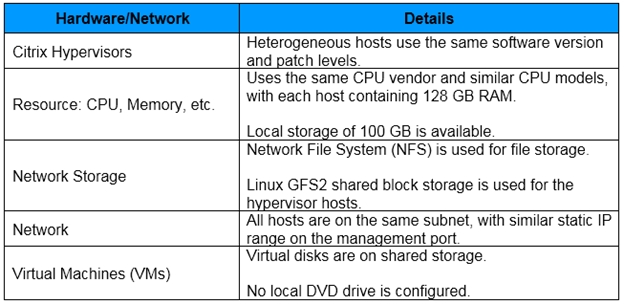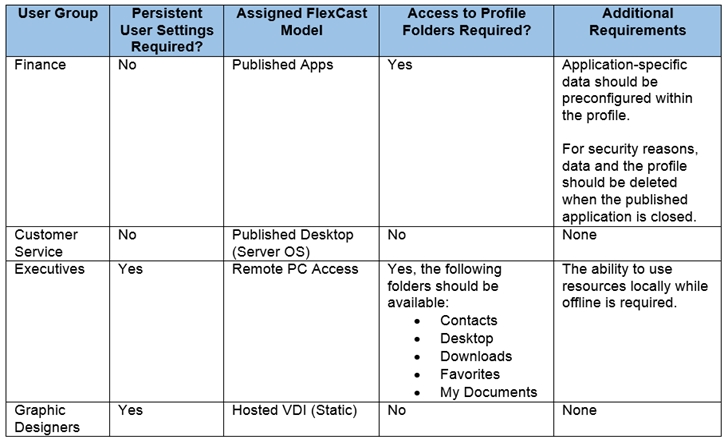Citrix 1Y0-403 - Citrix Virtual Apps and Desktops 7 Assessment Design and Advanced Configurations
Scenario: A Citrix Architect is designing a new Citrix Virtual Apps and Desktops environment. The environment will run on 2 Citrix Hypervisor platforms, each consisting of 3 NICs. The company maintains strict security standards for all business data traffic, so the architect is designing and configuring hypervisor network traffic to limit infrastructure vulnerabilities.
How should the architect configure the hypervisor network traffic to provide the best security for the environment?
Scenario: A Citrix Architect is designing a new Citrix Virtual Apps and Desktops environment. Currently, the environment is configured as 2 locations with identical Citrix Virtual Desktops Sites. Each Site has 2 Delivery Controllers, 2 StoreFront servers, and 1 Citrix ADC high-availability pair. The same applications have been published from both Sites for all users. Two zones (Zone A and Zone B) are configured in each Site with 1 Delivery Controller in each zone. The Microsoft Exchange server is only accessible from Virtual Delivery Agent (VDA) machines in Zone A in each Site.
Six access requirements have been identified:
Users should have a single URL when accessing resources from different Sites.
Users should always connect to the data center closest to their location.
Applications added to Favorites within the Citrix Workspace app should be retained when accessed from different Sites.
Launched applications and desktops should always connect through a local Citrix ADC.
No duplication of applications published from different Sites.
Microsoft Outlook should always launch in Zone A.
What should the architect recommend configuring to avoid duplication of the same applications being delivered from different Sites?
A Citrix Architect is designing a new Citrix Virtual Apps and Desktops environment. The IT team maintains 12 Citrix Hypervisor hosts that are available to build the new Citrix environment. During the project kickoff meeting, management states:
“We need a robust infrastructure that can handle large user loads, improve IT efficiency, guarantee minimal downtime, and protect the network and its resources from corruption.â€
Click the Exhibit button to view the existing infrastructure details.

Which configuration should the architect use to meet the requirements for the new Citrix environment?
Scenario: A Citrix Architect is designing a new Citrix Virtual Apps and Desktops environment. Currently, the environment is configured as 2 locations with identical Citrix Virtual Desktops Sites. Each Site has 2 Delivery Controllers, 2 StoreFront servers, and 1 Citrix ADC high-availability pair. The same applications have been published from both Sites for all users. Two zones (Zone A and Zone B) are configured in each Site with 1 Delivery Controller in each zone. The Microsoft Exchange server is only accessible from Virtual Delivery Agent (VDA) machines in Zone A in each Site.
Six access requirements have been identified:
Users should have a single URL when accessing resources from different Sites.
Users should always connect to the data center closest to their location.
Applications added to Favorites within the Citrix Workspace app should be retained when accessed from different Sites.
Launched applications and desktops should always connect through a local Citrix ADC.
No duplication of applications published from different Sites.
Microsoft Outlook should always launch in Zone A.
What should the architect recommend configuring subscription synchronization to retain applications added to Favorites?
Scenario: A Citrix Architect has developed the hardware requirements for a small production Citrix Virtual Apps and Desktops environment as follows:
Access to the environment hosted in a single data center
Ability to perform maintenance on the environment without requiring an outage
Keep management efforts to a minimum
Which hardware requirement does the architect need to include for Citrix Hypervisor hosts to meet the customer's needs?
What are three things a Citrix Architect should when using thin clones with Machine Creation Services (MCS)? (Choose three.)
Scenario: A Citrix Architect is designing a new Citrix Virtual Apps and Desktops environment. The customer previously installed all applications locally on managed laptops and desktops, but is willing to evaluate other application delivery methods as part of the new deployment. The environment will be standardized on Windows 10 for the Virtual Delivery Agent (VDA) machines.
As part of an application analysis performed earlier in the project, the information in the exhibit was collected regarding 1 of the required applications.
Click the Exhibit button to view the information.

The customer's security policies mandate that all development software must run within the corporate data center, but should appear to the user as if it is running locally on the virtual machine (VM).
How should the architect recommend deploying the application?
Scenario: A Citrix Architect is designing a new infrastructure that will use Citrix Virtual Apps and Desktops to deploy applications in New York, Chicago and Seattle data centers. All 3 data centers will be active simultaneously.
Which feature should the architect recommend to connect the remote users to the closest or best-performing data center?
Scenario: A Citrix Architect is designing a new Citrix Virtual Apps and Desktops environment. The architect has identified the Resource Layer requirements shown in the exhibit.
Click the Exhibit button to view the requirements.

Additionally, management identified 2 general Resource Layer requirements:
The time required to configure the solution should be minimized.
Different user groups can use different profile solutions.
Which profile type should the architect consider for the Finance Group?
Scenario: The IT team of a company configured its Citrix environment on Microsoft Azure. Load on the servers is nominal during the off season, but during peak season, load increases on the infrastructure servers. This load varies from year to year. A Citrix Architect is asked to design a solution that dynamically increases and decreases the number of infrastructure servers.
What should the architect recommend the IT team create in Microsoft Azure to meet this demand?



